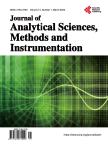Ultra Sensitive Determination and Preconcentration of Cd<sup>2+</sup>, Cu<sup>2+</sup>and Pb<sup>2+</sup>after Multi-Walled Carbon Nanotubes Adsorption
Ultra Sensitive Determination and Preconcentration of Cd<sup>2+</sup>, Cu<sup>2+</sup>and Pb<sup>2+</sup>after Multi-Walled Carbon Nanotubes Adsorption作者机构:Central Laboratory for Elemental and Isotopic Analysis Nuclear Research Center Atomic Energy Authority Cairo Egypt Central Laboratory for Elemental and Isotopic Analysis Nuclear Research Center Atomic Energy Authority Cairo Egypt Chemistry Department Faculty of Science Jazan University Jazan KSA Central Laboratory for Elemental and Isotopic Analysis Nuclear Research Center Atomic Energy Authority Cairo Egypt Physics Department Faculty of Science and Human Studies Shaqra University Shaqra KSA
出 版 物:《Journal of Analytical Sciences, Methods and Instrumentation》 (分析科学方法和仪器期刊(英文))
年 卷 期:2013年第3卷第1期
页 面:8-12页
主 题:Multi-Walled Carbon Nanotubes Graphite Furnace Atomic Absorption Spectrometry Inductively Coupled Plasma Optical Emission Spectrometry
摘 要:Multi-Walled carbon nanotubes are used as preconcentrating probes for the quantitative determination of trace cadmium, copper and lead in environmental and biological sample using graphite Furnace Atomic Absorption Spectrometry and inductively coupled Plasma Optical Emission spectrometry. The method is based on the electrostatic interactions of positively charged Cd+, Cu+ and Pb+ with the negatively charged multi-walled carbon nanotubes (MWCNTs) for the preconcentration and isolation of analytes from sample solutions. Effective preconcentration of trace cadmium, copper and lead was achieved in a pH range of 5 - 7, 5 - 7 and 4 - 7, respectively. The retained cadmium, copper and lead were efficiently eluted with 0.3 mol·L-1 HCl for graphite Furnace Atomic Absorption Spectrometry determination. The multi-walled carbon nanotubes packed micro-column exhibited fairly fast kinetics for the adsorption of cadmium, copper and lead, permitting the use of high sample flow rates up to at least 3 mL·min-1 for the flow injection on micro-column preconcentration without the loss of the retention efficiency. The detection limits (3σ) were 0.03, 0.01 and 0.5 ng·mL-1 for Cd, Cu and Pb, respectively. The relative standard deviation under optimum condition is less than 2.9% (n = 10). The developed method was successfully applied to the determination of trace Cd, Cu and Pb in a variety of environmental and biological samples.



